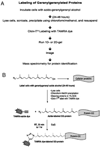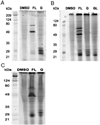A novel approach to tag and identify geranylgeranylated proteins
- PMID: 19784953
- PMCID: PMC2855049
- DOI: 10.1002/elps.200900259
A novel approach to tag and identify geranylgeranylated proteins
Abstract
A recently developed proteomic strategy, the "GG-azide"-labeling approach, is described for the detection and proteomic analysis of geranylgeranylated proteins. This approach involves metabolic incorporation of a synthetic azido-geranylgeranyl analog and chemoselective derivatization of azido-geranylgeranyl-modified proteins by the "click" chemistry, using a tetramethylrhodamine-alkyne. The resulting conjugated proteins can be separated by 1-D or 2-D and pH fractionation, and detected by fluorescence imaging. This method is compatible with downstream LC-MS/MS analysis. Proteomic analysis of conjugated proteins by this approach identified several known geranylgeranylated proteins as well as Rap2c, a novel member of the Ras family. Furthermore, prenylation of progerin in mouse embryonic fibroblast cells was examined using this approach, demonstrating that this strategy can be used to study prenylation of specific proteins. The "GG-azide"-labeling approach provides a new tool for the detection and proteomic analysis of geranylgeranylated proteins, and it can readily be extended to other post-translational modifications.
Conflict of interest statement
The authors have declared no conflict of interest.
Figures





Similar articles
-
Tagging-via-substrate strategy for probing O-GlcNAc modified proteins.J Proteome Res. 2005 May-Jun;4(3):950-7. doi: 10.1021/pr050033j. J Proteome Res. 2005. PMID: 15952742
-
A tagging-via-substrate technology for detection and proteomics of farnesylated proteins.Proc Natl Acad Sci U S A. 2004 Aug 24;101(34):12479-84. doi: 10.1073/pnas.0403413101. Epub 2004 Aug 12. Proc Natl Acad Sci U S A. 2004. PMID: 15308774 Free PMC article.
-
Evaluation of alkyne-modified isoprenoids as chemical reporters of protein prenylation.Chem Biol Drug Des. 2010 Dec;76(6):460-71. doi: 10.1111/j.1747-0285.2010.01037.x. Epub 2010 Oct 11. Chem Biol Drug Des. 2010. PMID: 21040496 Free PMC article.
-
Lamin A, farnesylation and aging.Exp Cell Res. 2012 Jan 1;318(1):1-7. doi: 10.1016/j.yexcr.2011.08.009. Epub 2011 Aug 16. Exp Cell Res. 2012. PMID: 21871450 Free PMC article. Review.
-
Exploring the biochemistry of the prenylome and its role in disease through proteomics: progress and potential.Expert Rev Proteomics. 2017 Jun;14(6):515-528. doi: 10.1080/14789450.2017.1332998. Epub 2017 May 26. Expert Rev Proteomics. 2017. PMID: 28521569 Review.
Cited by
-
Synthetic isoprenoid analogues for the study of prenylated proteins: Fluorescent imaging and proteomic applications.Bioorg Chem. 2016 Feb;64:59-65. doi: 10.1016/j.bioorg.2015.12.003. Epub 2015 Dec 10. Bioorg Chem. 2016. PMID: 26709869 Free PMC article. Review.
-
Prenylome profiling reveals S-farnesylation is crucial for membrane targeting and antiviral activity of ZAP long-isoform.Proc Natl Acad Sci U S A. 2013 Jul 2;110(27):11085-90. doi: 10.1073/pnas.1302564110. Epub 2013 Jun 17. Proc Natl Acad Sci U S A. 2013. PMID: 23776219 Free PMC article.
-
Regioselective covalent immobilization of catalytically active glutathione S-transferase on glass slides.Bioconjug Chem. 2013 Apr 17;24(4):571-7. doi: 10.1021/bc300462j. Epub 2013 Mar 26. Bioconjug Chem. 2013. PMID: 23458569 Free PMC article.
-
Protein prenylation: enzymes, therapeutics, and biotechnology applications.ACS Chem Biol. 2015 Jan 16;10(1):51-62. doi: 10.1021/cb500791f. Epub 2014 Dec 8. ACS Chem Biol. 2015. PMID: 25402849 Free PMC article. Review.
-
A Not-So-Ancient Grease History: Click Chemistry and Protein Lipid Modifications.Chem Rev. 2021 Jun 23;121(12):7178-7248. doi: 10.1021/acs.chemrev.0c01108. Epub 2021 Apr 6. Chem Rev. 2021. PMID: 33821625 Free PMC article. Review.
References
-
- Tamanoi F, Sigman DS, editors. The Enzymes. Vol. 21. San Diego: Academic Press; 2001.
-
- Zhang FL, Casey PJ. Annu. Rev. Biochem. 1996;65:241–270. - PubMed
-
- Glomset JA, Gelb MH, Farnsworth CC. Trends Biochem. Sci. 1990;15:139–142. - PubMed
-
- Cox AD, Der CJ. Curr. Opin. Cell Biol. 1992;4:1008–1106. - PubMed
Publication types
MeSH terms
Substances
Grants and funding
- GM07185/GM/NIGMS NIH HHS/United States
- R01 HL086683/HL/NHLBI NIH HHS/United States
- R01 GM066152/GM/NIGMS NIH HHS/United States
- R01 AR050200/AR/NIAMS NIH HHS/United States
- T32 GM007185/GM/NIGMS NIH HHS/United States
- HL86683/HL/NHLBI NIH HHS/United States
- CA41996/CA/NCI NIH HHS/United States
- R01 HL076839/HL/NHLBI NIH HHS/United States
- R01 AG035626/AG/NIA NIH HHS/United States
- R01 CA041996/CA/NCI NIH HHS/United States
- HL76839/HL/NHLBI NIH HHS/United States
- AR050200/AR/NIAMS NIH HHS/United States
- GM66152/GM/NIGMS NIH HHS/United States
LinkOut - more resources
Full Text Sources

